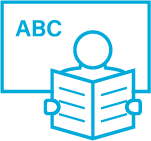A Review of Literacy Interventions for Adults with Extensive Needs for Supports

Adults with disabilities can be helped to learn and to improve their literacy skills by beginning with high expectations, building instruction around each individual’s goals, and using systematic, integrated instruction.
Authors: Susan R. Copeland, Jessica A. McCord, & Ashely Kruger
Source: Copeland, S.R., McCord, J.A., & Kruger, A. (2016). A review of literacy interventions for adults with extensive needs for supports. Journal of Adolescent and Adult Literacy, 60(2), 173–184. DOI: 10.1002/jaal.548
Adults with disabilities can be helped to learn and to improve their literacy skills by beginning with high expectations, building instruction around each individual’s goals, and using systematic, integrated instruction.
- Acquiring literacy skills is critical for all adults.
- Literacy can empower an individual to be an active citizen in the democratic process, open up educational and employment opportunities that can lead to economic stability, facilitate health and well-being, create access to recreation and leisure activities, and enhance self-confidence.
- In this review, the population of individuals who require assistance across all aspects of their lives is considered. This includes individuals with intellectual disability (ID), autism spectrum disorder (ASD), or multiple disabilities.
- Instruction for adults should consider their typically pragmatic, problem-centred orientation to learning.
- Motivation, self-direction, and task/learning organisation all appear to play important roles in the experiences of most adult learners.
- Many adults with disabilities did not receive appropriate, individualised, systematic, and sustained literacy instruction while they were in school and therefore did not acquire literacy knowledge and skills.
- It is recognised that literacy learning is a lifelong process, not something that ends when compulsory education stops.
- Literacy encompasses both the skills needed to make meaning out of symbols (e.g. decoding and encoding text) and the broader uses of literacy within an individual’s life.

Present study
This review first investigates instructional interventions to teach acquisition of the skills needed to read. Second, it focuses on describing and evaluating the types of literacy instruction programmes available to adults. Therefore, it sought to describe the participants in this area of research, the types of literacy targets represented, the types of interventions used, and the outcomes of these interventions.
Participants In total, 169 adults aged between 18 and 57 years participated in the studies. Participants in 14 studies had a primary diagnosis of ID, and participants in three studies had a primary diagnosis of ASD.

Findings
- Many of the reviewed studies focused on multiple literacy targets and combined more than one instructional strategy or approach into an intervention package.
- Intervention targets fell into three general categories: word identification (with and without a focus on word meaning); reading or listening text-level comprehension of narrative or expository text; and multiple literacy targets taught within integrated instruction.
- The primary intervention categories were behavioural strategies, which used tightly controlled presentation of items to be taught and strategic use of reinforcement; visuals (such as symbols); strategy-based interventions; and multiple-component interventions.
Behavioural strategies
- Time delay begins by simultaneously showing and reading/defining a word and asking the student to repeat the word/definition. The teacher then presents the word but waits a specified number of seconds for the student to respond before providing a prompt.
- Participants learned to read and provide definitions of label words and were able to generalise these skills across novel products (but not across settings).
Visuals
- Researchers in three studies specifically examined whether pairing visuals (such as pictures or symbols) with text helped adults learn literacy skills.
- Participants with lower reading levels benefited more from using symbolised text than those with higher skill levels.
Strategy-based interventions
- The repeated reading intervention Reread-Adapt and Answer-Comprehend (RAAC) increased participants’ fluency (correct words per minute) immediately following the intervention as well as their accuracy in answering factual and inferential comprehension questions.
- By teaching summarising, questioning, clarifying, and predicting, the use of strategies after the intervention increased and showed significant transfer of comprehension skills to standardised measures of reading comprehension.
- Teaching use of question words, prediction, and retelling helped to increase reading accuracy, fluency, and comprehension on standardised measures.
Multiple-component interventions
- Instruction in phonological awareness, word identification, syntax rules, and text and narrative reading comprehension improved the experimental group’s performance with word identification in oral production and silent reading and comprehension at the sentence level (but not narrative comprehension).
- Teaching phonological awareness, phonics knowledge, sight word vocabulary, understanding of text structure, and ability to compose text all improved discrimination of beginning sounds, acquisition of nine sight words, concepts about print, and confidence with literacy tasks.

Implications
- All the reviewed studies documented an improvement in participants’ literacy skills across widely varying interventions, demonstrating that individuals with extensive support needs can acquire new literacy skills well into adulthood.
- Comprehension is the purpose of reading; therefore, it is encouraging that over half of the studies reviewed focused on teaching reading comprehension and vocabulary knowledge instead of focusing solely on word recognition.
- Teaching for comprehension from the beginning of word recognition instruction, and using instructional materials based on adults’ interests, are both likely to increase engagement and meaning making, and to facilitate comprehension.
- Strategies such as graphic organisers might also support short-term memory.
- Writing as a component of literacy instruction should be included.
- It is recommended to teach for transfer and generalisation by linking instruction to student’s interests and life.